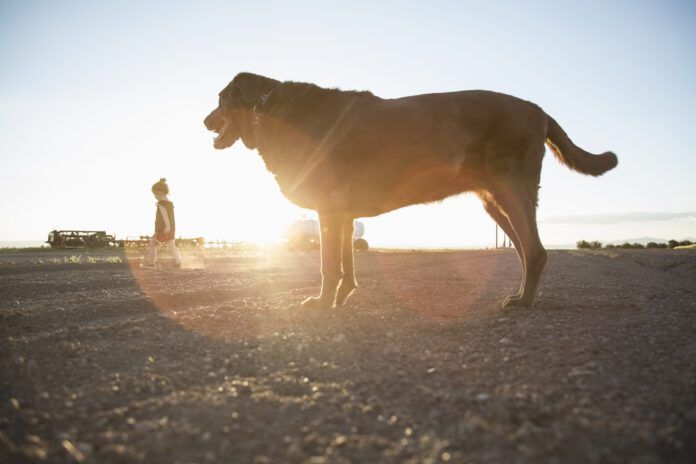
Valley fever is the common name of a medical condition called coccidioidomycosis (pronounced cock-sid-ee-oy-doh-my-KOH-sis) that can affect dogs and humans alike. The illness is also known as San Joaquin Valley Fever (named for the southern half of California’s Central Valley), desert fever, and desert rheumatism. Valley fever is caused by the inhalation of a species of fungus called Coccidioides that thrives in the soil of semi-arid regions with warm winters. Most dogs who develop symptoms of Valley fever will have the pulmonary form of coccidioidomycosis, presenting with a cough, fever, decreased appetite, and weight loss. However, if the Valley fever fungus infection spreads to other parts of the body, dogs can have other signs of illness, such as:
- Pain and/or swelling in joints and limbs
- Limping (lameness) or difficulty walking
- Back or neck pain
- Neurologic signs, including seizures, changes in vision, and loss of muscle control
- Lumps and bumps under the skin
- Swollen lymph nodes around the jaw, in front of the shoulder blades, or behind the back legs
- Skin wounds that drain fluid
- Swelling and redness of the eye and surrounding skin with pain and cloudiness
How Dogs Get Valley Fever
The Coccidioides fungus grows in the soil of semi-arid regions with warm winters, and can be found as much as 12 inches below the soil surface. This fungus is found primarily in the southwestern United States, including California, Arizona, Nevada, Utah, New Mexico, and Texas, though there have been reports of the fungus being found in south-central Washington state. (It’s so prevalent in California’s Central Valley, that the California Department of Public Health maintains a Valley Fever web page with case rates and other information about its risks.) Internationally, it is endemic to areas of Mexico and several Central and South American countries.
The growth of the Coccidioides fungus is accelerated after a period of rainfall, when microscopic spores called arthroconidia develop on strands of the fungus. Once the soil dries out in the summer, these spores are released into the air – especially if the dried soil is disturbed by natural forces, such as a windstorm or an earthquake, by digging in the soil (as with farming, gardening, landscaping, or during construction), or by off-road vehicles.
Dogs, humans, and many other species of animals can contract Valley fever by inhaling these microscopic arthroconidia. In most cases, the fungal spores remain in the lungs and do not spread to other areas of the body. But if they enter the bloodstream or the lymphatic system, they can spread to any other area of the body, including the brain, bones, joints, skin, lymph nodes, and visceral organs.
-About 40% of dogs exposed to the Coccidioides fungus will become ill.
-Most dogs who become ill with Valley fever have the pulmonary form of the disease, which has a good prognosis if identified and treated promptly.
-Diagnosis of Valley fever is not always straightforward and may require a treatment trial with antifungal medications.
-Antifungal medications have side effects and periodic monitoring of kidney values or liver enzymes will be necessary.
-A small percentage of dogs exposed to the Coccidioides fungus will develop a latent infection. These dogs may take up to three years following exposure to show symptoms of Valley fever. If your dog is ill, be sure to tell your veterinarian about your dog’s travel history and places your dog has previously lived.
Symptoms of Valley Fever in Dogs
Most dogs who develop symptoms of Valley fever will have the pulmonary form of coccidioidomycosis. In these cases, the Coccidioides fungus is contained within the lungs and does not spread to other areas of the body. Some of these dogs may also develop a fever, have a decreased appetite, and experience weight loss.
A small percentage of symptomatic dogs may develop disseminated coccidioidomycosis. This is a condition in which the fungal spores enter the bloodstream or the lymphatic system and spread to other areas of the body. The symptoms a dog with disseminated coccidioidomycosis will experience will vary depending on which parts of the body have been infected.
Dogs with disseminated Valley fever may experience neck or back pain, joint pain, nodules on the skin, and swelling of the eyes and altered vision. If the fungus has spread to the brain, then changes in walking, balance, or behavior may occur. Open skin sores that drain fluid (known as draining tracts) may occur over areas of soft tissue, joints, or bones where the fungus is residing.
Disseminated coccidioidomycosis can also cause fevers that come and go, decreased appetite, and weight loss. Other symptoms associated with specific organ dysfunction may arise if the fungal spores have spread to organs such as the heart, liver, kidneys, and pancreas.
About 40% of dogs exposed to the Coccidioides fungus will develop a cough about one to four weeks after inhaling the fungal spores. A small percentage of dogs may develop a latent infection, remaining symptom free for up to three years after exposure to the Coccidioides fungus before developing a cough or other symptoms.
The majority of dogs exposed to the Coccidioides fungus are asymptomatic, meaning they do not develop symptoms of Valley fever. About 60% of dogs exposed to the Coccidioides fungus will remain asymptomatic.
Diagnosis of Valley Fever
Diagnosing coccidioidomycosis in any animal, including dogs and humans, can be challenging. As of this writing, there is no single test that can definitively diagnose Valley fever. A diagnosis is made by correlating symptoms with possible exposure to the fungal spores, imaging (such as radiographs, CT, or MRI), antibody titer testing, and cytology of affected bodily fluids.
A dog with Valley fever may have thoracic radiographs (chest x-rays) that show an infiltrative pattern to the lungs and enlarged lymph nodes in the chest. But this type of appearance on radiographs is not specifically indicative of Valley fever. Other diseases, such as metastatic cancer, can have the same appearance on radiographs.
There are many different diseases that can cause coughing in dogs, so thoracic radiographs will be necessary to eliminate other possible causes for your dog’s cough. These causes include (but are not limited to) pneumonia, bronchitis, collapsing trachea, and congestive heart failure, all of which have a different appearance on radiographs than Valley fever.
A computed tomography (CT) scan may be more sensitive at detecting spherules within the lungs. This can help differentiate Valley fever from other causes of an infiltrative pattern on radiographs. If a dog that is suspected to have Valley fever is exhibiting neurologic signs, then magnetic resonance imaging (MRI) may show the presence of fungal spherules (regenerating structures that produce more fungal spores) in the brain.
Antibody titer testing may be helpful in determining if a dog has Valley fever. A high antibody titer for the Coccidioides fungus in a dog showing symptoms of Valley fever is supportive of a diagnosis of coccidioidomycosis. However, some dogs may not develop antibodies for several weeks after becoming ill, so a negative antibody titer does not rule out Valley fever.
Cytology (examination of cells under a microscope) of the patient’s bodily fluids (exudates) may reveal the presence of fungal spores. If your dog is coughing, a procedure called a transtracheal wash can be used to recover fluid from the lower airway for analysis. Fluid from draining tracts of the skin can also be analyzed for the presence of spores. If a spherule has not yet ruptured and released spores, then a cytology test may be negative even if a dog has Valley fever.
Sometimes a treatment can be used as a diagnostic tool. If a dog responds to a specific treatment, then that may be supportive of a diagnosis. A treatment trial with antifungal drugs may be used as a diagnostic tool if:
- the dog is exhibiting the symptoms of coccidioidomycosis
- the dog lives, has lived, or has traveled to a geographic area known to be endemic for the Coccidioides fungus
- tests for Valley fever have been negative
- other causes of the dog’s symptoms have been ruled out
- the dog’s symptoms have not responded to other treatment regimens
Treatment of Valley Fever
Coccidioidomycosis is treated with a lengthy course of antifungal drugs. These medications include amphotericin B or one of the “azole” class of antifungal drugs: ketoconazole, itraconazole, fluconazole, or posaconazole. Sometimes a combination of an azole drug with anti-fungal drug called terbinafine is used.
Amphotericin B is only available as an injectable drug, not an oral medication. The most common side effect of this medication is kidney damage. This damage is often reversible but may take several months after discontinuing amphotericin B for the kidneys to recover.
The azole class of medications can cause liver damage. Like amphotericin B, this damage is often reversible once the medication is discontinued. Elevated liver enzymes can also be observed in dogs taking terbinafine.
Dogs receiving amphotericin B will need to have their kidney values closely monitored. Liver enzymes will need to be periodically monitored in dogs receiving terbinafine or one of the azole class of drugs.
Treatment for the pulmonary form of coccidioidomycosis typically requires being on antifungal medications for three to six months. The response to treatment is usually good and most dogs with the pulmonary form will make a complete recovery.
Dogs who have disseminated coccidioidomycosis will likely require treatment for a year or more. Some dogs with this form of the disease may require treatment for the remainder of their lives. A small number of these dogs do not recover from their illness while some recover but have lifelong effects depending on where the fungal spores spread in their bodies.
How to prevent Valley Fever in dogs
If you live in an area endemic to Valley fever, then exposure to the Coccidioides fungus is unavoidable. But there are things you can do to minimize the risk of your dog becoming ill with Valley fever:
- Avoid outdoor activity during or just after dust storms and in the days following an earthquake
- Avoid walking near construction sites or other areas where the soil is being mechanically disturbed
- Do not allow your dog to dig in desert soil
- Plant ground cover on your property that reduces dust circulation, such as grass or gravel
Although dogs can develop Valley fever at any time of year, the number of cases reported in both humans and animals is highest from mid-summer to late autumn.
A vaccine for coccidioidomycosis is currently under development and has shown promise in preventing Valley fever in dogs.






I had a beautiful, dearly-loved Borzoi who was born and raised in the Central Valley of CA for her first 2 years. Fast forward to her 9th year and she suddenly went lame in her right shoulder, and by then we were living in the Pacific Northwest. Her x-rays showed that her shoulder bone was basically disintegrating. My vet (not knowing my dog was from CA) said “I have never seen bone cancer look like this. I went to vet school at Davis and if I didn’t know better I would say this was Valley Fever.” And it was. As I scrutinize her past for any other symptoms, there was some occasional back/neck pain that always resolved itself after a day of rest which might not have been related- but no respiratory symptoms. We were shocked and heartbroken. Thank you for spotlighting this important topic- people can get it too, so we all need to be careful.